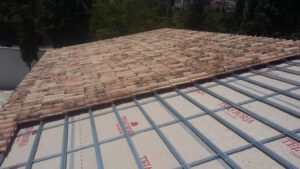Roofers are professionals who specialize in the construction of roofs. They repair, replace, and install roofs, and work with a variety of materials. These professionals are often referred to as roof mechanics or roofing contractors. Read on to learn about the education and training requirements for this occupation and potential earnings. Then, make an informed decision about whether this is the right career for you.

Roofing is a popular profession, and demand is expected to continue to grow for years to come. Unlike many other construction occupations, the demand for roofers is less susceptible to economic downturns. As a result, job openings are likely to be plentiful. Typically, the peak months for employment are the spring and summer, when demand is highest. However, there is always the potential for seasonal fluctuations.
Most employers prefer applicants who are over 18 years of age and have good physical condition and balance. High school education is not required but often preferred. There are several courses available that can help students learn the skills they need to become a roofer. The courses can include basic mathematics, mechanical drawing, and shop.
Those who scored well on the realistic theme were described as reliable, practical, thrifty, and determined. They are also reserved, hardworking, and self-reliant. They are also driven by the challenge of building and enjoy the outdoors.
The employment outlook for roofers is generally positive. However, there are some potential negative factors. While new construction jobs will likely grow slower than the overall population, roofers will continue to have plenty of work. In addition to new construction, roofers will also see plenty of repair work and maintenance work. In addition, because 75% of roofing work is on existing buildings, jobs will continue to be plentiful as long as new construction projects are being built.
In 2004 there were 162,000 roofers working in the States. The majority of these roofers worked for contractors. Despite the high turnover rate in the industry, employment is expected to rise faster than the average for all occupations through 2012. In addition, the demand for roofers will continue to grow, as workers will be required to replace those who leave the field. Another benefit to this career is that the work is largely repair and replacement, which makes it less dependent on economic conditions.
The Bureau of Labor Statistics predicts that employment for roofers will grow by 5 percent between 2019 and 2029. The demand for these workers is expected to grow across all sectors of construction, and therefore should increase as overall construction activity increases. The majority of roofers are male, with women making up a small percentage. This chart shows the gender breakdown of roofers. requirements
To become a roofer, you need to be at least 18 years old, in the good physical condition, and have a good balance. Some employers prefer that you have a high school education. You may want to take courses in mechanical drawing or basic mathematics. In addition, experience with metalworking is helpful. After completing your training, you can become a supervisor or even a roofing contractor yourself.
Most roofers learn on the job. However, if you’d like to become a roofer, you should consider an apprenticeship program. This program is typically three years long and involves a combination of on-the-job training and classroom instruction. During the apprenticeship, you’ll receive training in mathematics, arithmetic, and safety procedures. You’ll also be able to use specialized tools and learn about building codes.
Education requirements for roofers vary by company. Some roofers require a high school diploma, but many others need an associate’s degree or a diploma. Regardless of your education level, you can expect to make over $70,000 a year, if you’re trained and skilled. In addition, you’ll enjoy a variety of work environments and a recession-proof job outlook.
